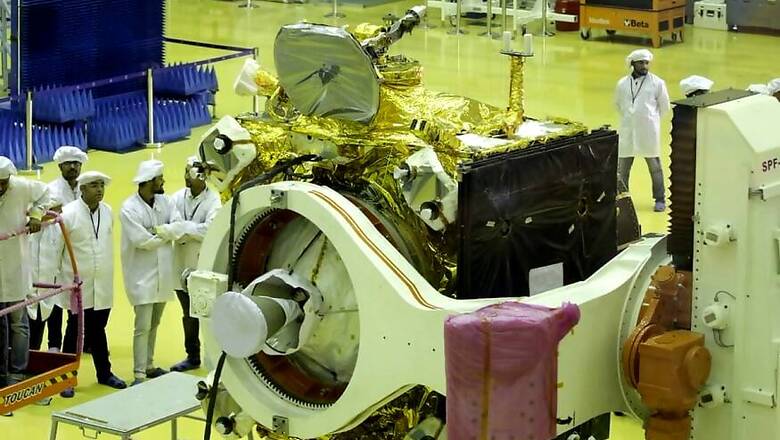
views
Bengaluru: India has been over the moon ever since ISRO announced that the country’s third space exploration mission, Chandrayaan-2, was being steered by two women.
Project director Vanitha Muthayya and mission director Ritu Karidhal have become overnight heroes for women in science, technology, engineering and mathematics (STEM), and womankind in general.
But their journeys have not been easy.
Muthayya, for instance, was quite reluctant to take up the post of project director. It took several rounds of persuasion to bring her on board as being in-charge of a project with national ramifications, like Chandrayaan-2, would mean a huge responsibility; one that can make many question themselves on whether they should take it up.
“Vanitha is an expert in data handling. She was comfortable in her digital/ hardware section and was hesitant to move to a project director role. This role not only involves nearly 18 hours of work a day at its peak, which means many sacrifices, but is also in the national limelight bringing heavy responsibility of its own," says Dr M Annadurai, who was project director of Chandrayaan-1 and was instrumental later in persuading Muthayya to accept the post for Chandrayaan-2.
At the time, the Indian Space Research Organisation (ISRO) was planning the mission for around April 2018. Her roles earlier were related to data imaging, handling data sent back from remote-sensing missions and interpreting data from different payloads of spacecraft like Chandrayaan-1, some of it very complex, each bringing its own set of difficulties.
“She has excellent problem-solving skills. We knew that would help. And when it comes to managing teams, she was very good with that too. That always helps on the project side because ultimately it is team work. So we put extra effort to get her on board as the project director," says Dr Annadurai, who had by then been promoted as director of the UR Rao Satellite Centre in Bengaluru.
Ritu Karidhal, on the other hand, is a younger scientist who had always been involved in mission operations. She was used to long hours and knew that a 9-to-5 schedule is something she would never enjoy.
The mission group works on planning and execution of different maneouvres. For example, Chandrayaan-2 will undertake a nearly 50-day journey from Earth to moon. The precise launch window is just a 10-minute one between 2:51 am and 3:01 am on July 15, a Monday. If this fails, they get just a one-minute window in other days in July where they would have to launch this spacecraft.
Once launched, the moon-craft will have to be separated from the rocket, and later, scientists led by Karidhal will be executing five burns of the liquid engine over the next 15-16 days. After that, a five-day maneouvre called a Trans-Lunar Burn will inject this craft into the lunar orbit and this would keep going from a distance of 100 km from the moon to as close as 30 km.
All these maneouvres will be executed from the ground station in Bengaluru, but the most complex one will have to be done by the in-built systems on the Lander of Chandrayaan-2; the lander which will have to navigate its way to soft-land on the moon’s surface.
It’s going to be the most gripping 15 minutes for the scientists not just because they have never done anything like this before, but because this is left to the instruments on board the lander and cannot be controlled on ground.
Getting this precision, looking at a second-by-second advancing of the lander has been Karidhal’s responsibility as of now. But it is not new for her. She was one of the two key operations managers for the Mars Orbiter Mission in 2013, the other being Nandini Harinath.
While Karidhal took care of the entire guidance of the Mars-craft from launch to entering Martian orbit, an 11-month-long journey, Nandini took care of the Mars Orbiter's journey after it reached the orbit in September 2014.
“It’s as though you are the driver or pilot when the car is ready. A lot of operations are called for there, and she is used to handling the overall system. From day 1 (as a scientist at ISRO) she has been in the mission side and it is more like a smooth transition to Chandrayaan-2," says Dr Annadurai.
Karidhal herself describes her work on Mars Orbiter as someone who is trying to sit in India and achieve the correct cruise path for a golf ball that is hit towards a tee-hole in Los Angeles. “The ball has to go straight into the hole, and to make it more challenging, the hole is moving," she says in one of her TedX talks on the challenges of flight maneouvring a spacecraft between two moving planets.
The systems on-board have to be configured precisely to ensure they work autonomously, correcting their own path if there are challenges, with smart technology that addresses problems along the way.
It was the complexity of the lander, in fact, that led to some delays in the project over the last few months as some of the requirements were changed. It meant re-working and re-testing the systems before they were finally ready.
Both women have worked with ISRO for more than 20 years, and this step towards a new frontier was a giant leap for women in STEM.

















Comments
0 comment